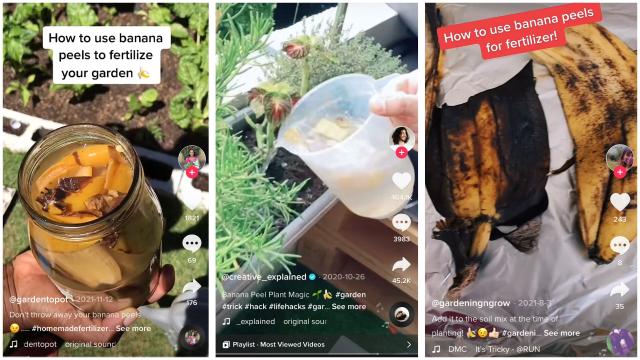To hear TikTok tell it, banana peels are an amazing fertiliser for your garden due to their high potassium content and the fact that you get them basically for free (assuming that you eat bananas). The reality is a lot less exciting.
Nonsensical gardening tips have always been passed around, sometimes by literal word of mouth, books, newsletters, or Facebook comments. TikTok is just particularly good at the job because you can provide convincing footage while almost completely eliminating any context, source material, or opportunity for discussion. So, let’s dig in.
How can you use banana peels in your garden?
The usual recommendation is to steep banana peels in water, and use the resulting liquid to water your vegetables or flowers. There are also variations that have you dehydrate the banana peels and grind them up, or chop them into pieces and bury them in your garden soil.
Supposedly the peels are high in potassium, which is one of the nutrients plants need to grow — if you buy packaged fertilisers, you’ll notice that they have three numbers on the front indicating their percentage of nitrogen, phosphorus, and potassium (known as NPK, after those elements’ chemical abbreviations). For example, a 1-1-1 fertiliser contains all three in equal proportions.
Are banana peels really high in potassium?
Bananas have a reputation for being high in potassium when we’re talking about nutrition. But if you look up the actual numbers, you’ll find that a potato has more potassium than a banana. So do canned tomatoes, lima beans, carrot juice, parsnips, orange juice, kiwi fruit, a cup of yogurt, or a three-ounce portion of tuna. Bananas aren’t a potassium powerhouse, they’re just one of many foods that can provide the nutrient.
So how do banana peels compare to other potassium-containing fertilisers? One gardener ran the numbers and found that fresh banana peels have an NPK of 0.1-0.1-2.3. Steeping the peels in water isn’t going to do much to remove the potassium from the peels, so if you’re using the tea method, you’ll be getting even less. Meanwhile, you can buy langbeinite 0-0-22 fertiliser for around 45 cents per 450 g.
What should I actually do with my banana peels?
If you truly want to fertilize your garden with kitchen scraps, there is an effective and time-tested method for doing that, which also has the advantage of providing nitrogen and other nutrients to the soil. It’s called composting.
We have a guide to composting here. Once you have your compost bin set up, you can just toss your banana peels in, along with other fruits, vegetables, and plant matter (my family includes paper towels and dried-out yard waste in ours).
The result is a nutrient-rich, soil-like substance that you can work into your garden soil before you begin the growing season, or use to side-dress established plants. And it’s a lot less work than making a watery banana smoothie every time you want to dispose of a few peels.

Leave a Reply
You must be logged in to post a comment.